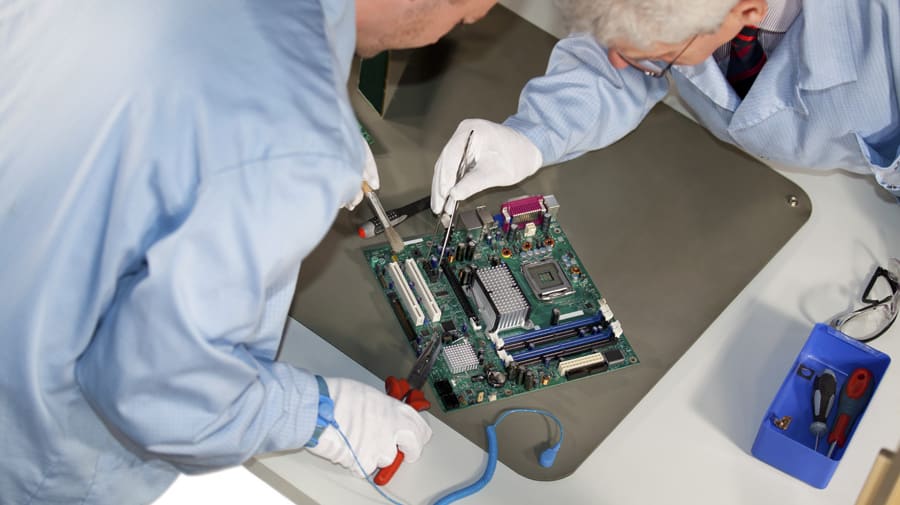Electrostatic Discharge (ESD) happens every day and usually goes unnoticed. It’s a momentary electric shock given off by a person, or any other object that runs on electrical impulses. It isn’t anything to worry about in everyday life, but that is far from the case if you are involved in the electronics industry. If the correct procedures are not in place, an ESD can instantly damage sensitive components.
The problems caused by ESD were first recognized when MOSFETs were introduced in the early 1960s. In today’s highly sophisticated technological world, many devices demonstrate this sensitivity, and if a high failure rate is to be avoided, then systems have to be put into place to minimize ESD.
Static electricity can not only cause parts to fail but can enable contaminants to gain a foothold in otherwise clean areas, make items stick together and even ignite flammable materials. Without eliminating ESD, an organization runs the risk of multiple failures and possible damage to both employees and buildings.
The ESD Association was set up to develop the theory and practice of electrostatic discharge avoidance and has diversified to cover not only the electronics industry but also cleanrooms, graphic arts, plastics and textiles.
Twenty years ago, the ESD Association published guidelines that can be utilized to secure the workplace from ESD in a program called ANSI/ESD S20.20. The standards they developed allow the design, implementation, and the continuance of processes that remove the threat of ESD from sensitive electronic components and equipment. By tailoring these standards to your own needs, a business can put in place a regime that negates ESD, reduces failure and helps to keep customer confidence high.
ANSI/ESD S20.20 Control Program
The ANSI/ESD S20.20 has become the industry standard in every high-tech industry, from telecommunications and aerospace to automotive and electronics. Any business can use it to ensure that working environments are protected from charges of 100v or more.
Implementing an ESD control program is vital for businesses that need to reduce or eliminate component failures and increase the quality of their products.
An ESD program offers the following benefits:
- Increases ESD awareness throughout the organization
- Improves the standard to which all processes are held
- Saves money
- Reduces failures and necessary
- Ensures you’re working at the same standard as others in your industry
- Offers proof to potential clients of your quality
- Increases your marketability
ESD controls include:
- Wrist straps: this ensures that seated or standing personnel are connected to the grounding system when handling sensitive items.
- Footwear: any standing personnel should wear footwear connected to a flooring system
- Garments: clothing should have continuity from one sleeve to the other, and should meet resistance requirements
- Flooring: epoxy-based flooring is common for large concrete areas, grounded through copper strips. A post-installation test should always be performed. The threshold for ESD control flooring is one megaohm
- Shelving, seating, and soldering and desoldering tools should all be grounded, even if ESD mats are used
- ESD protected areas: areas should have well-defined boundaries. Where this is not possible, ionisers should be used to ground/neutralise ESD.
- Other considerations:
- Surface resistivity meters
- Grounded worksurfaces
- Packaging
- Marking
- Gloves (decay of charge to less than 10% of the initial value within 2 seconds is required)
- Conveyor systems
- Ensuring that all nonessential personal items are outside ESD areas
3 Key Elements of an ESD Program
Every ESD program should have a 3-pronged approach:
ESD Control Program Plan
This provides the technical and administrative requirements so that an organization can set up and maintain a sustainable and thorough ESD control program. ESD prone components should be identified, systems put in place so that all conductors (including technicians) are grounded, and insulators minimized or neutralized.
ESD Training Plan
This explains how you should implement a training plan that educates operatives in the details of your ESD program. It encourages full and detailed training that uses various tools so that every technician understands what is required, which is reinforced by regular retaining.
All involved personnel must understand their responsibility in regard to the ESD program, and the threat ESD poses to the quality of the products they are working with. Signage can often serve as a simple reminder. Failure to comply should be addressed or reported to the ESD coordinator.
Compliance Verification Plan (Audit)
Having a plan and training the technicians is not enough. A rigorous timetable of checking, verification, and reappraisal has to be in place if your ESD control measures are to be successful. This involves regular audits of people, procedures, and equipment to ensure that standards are maintained and any problems addressed.
ESD Coordinator
You need to appoint an ESD Coordinator (or multiple, if necessary), who will have a number of responsibilities, including:
- Addressing personnel questions or failures to comply
- Ensure a written copy of your ESD plan is available to all necessary staff
- Maintain lists of ESD equipment
- Ensure regular training and maintain a list of trained personnel
- Make key decisions in regard to the ESD, such as frequency of audits
Complying with the standards set out in the ANSI/ESD S20.20 makes perfect business sense. Not doing so runs the risk of poor customer experience and lost revenue. The principles set out in the ESD Association’s published materials are straightforward to adhere to and vital if your organization is to run optimally. When you consider that one failed component might lead to a lost customer, then any time and expense involved in implementing the program are worth every cent.











